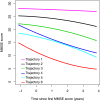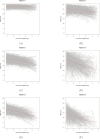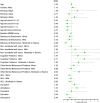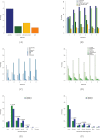Trajectories of dementia-related cognitive decline in a large mental health records derived patient cohort
- PMID: 28591196
- PMCID: PMC5462385
- DOI: 10.1371/journal.pone.0178562
Trajectories of dementia-related cognitive decline in a large mental health records derived patient cohort
Abstract
Background: Modeling trajectories of decline can help describe the variability in progression of cognitive impairment in dementia. Better characterisation of these trajectories has significant implications for understanding disease progression, trial design and care planning.
Methods: Patients with at least three Mini-mental State Examination (MMSE) scores recorded in the South London and Maudsley NHS Foundation Trust Electronic Health Records, UK were selected (N = 3441) to form a retrospective cohort. Trajectories of cognitive decline were identified through latent class growth analysis of longitudinal MMSE scores. Demographics, Health of Nation Outcome Scales and medications were compared across trajectories identified.
Results: Four of the six trajectories showed increased rate of decline with lower baseline MMSE. Two trajectories had similar initial MMSE scores but different rates of decline. In the faster declining trajectory of the two, a higher incidence of both behavioral problems and sertraline prescription were present.
Conclusions: We find suggestive evidence for association of behavioral problems and sertraline prescription with rate of decline. Further work is needed to determine whether trajectories replicate in other datasets.
Conflict of interest statement
Figures




References
-
- Verlinden VJA, van der Geest JN, de Bruijn RFAG, Hofman A, Koudstaal PJ, Ikram MA. Trajectories of decline in cognition and daily functioning in preclinical dementia. Alzheimer's & Dementia. 2015. - PubMed
MeSH terms
Grants and funding
LinkOut - more resources
Full Text Sources
Other Literature Sources
Medical

